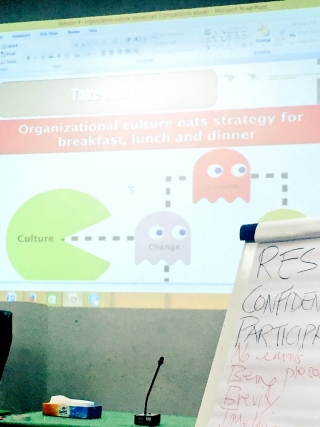Culture is the Problem: Culture Is the Solution : Performance Driven Organisations

One of the measures of organizational leadership effectiveness is corporate performance. Business and Public Leaders are measured by their ability to take high-level goals and translate them into results, through their workforce. Boards demand it from their Chief Executives, Chief Executives demand it from their Managers, Managers demand it from their Team Leaders and Members, and Team Members demand it from one another. It is therefore, a foregone conclusion that stakeholders expect, desire and demand that Business and Public Organizations perform. The concept of performance and result-orientation is now at least a well-accepted mantra across the Society. What seems to be a more difficult concept is actually development of a Culture of Discipline and High Performance. In twenty-two (22) interviews with CEOs in 2014, it was interesting to note that the only thing on their minds is how to drive Organizational Performance and they all said that “The Culture was the Problem”, and in every case “The Culture was the Solution.” Building the right culture maybe the hardest thing that a Leader does and maybe the most rewarding Legacy that he or she leaves behind.
In the landmark well-researched book by Steve Zaffron and Dave Logan, on the Laws of Performance, the authors explain that rewriting the culture is the key to rewriting the future for people and organizations. The result is the transformation of a situation, leading to a dramatic elevation in performance. Rewrite the future and people’s actions naturally shift: from disengaged to proactive, from resigned to inspired, from frustrated to innovative. Rewriting an organization’s future is the task of the Leader and it cannot be delegated. Sometimes a CEO pays a Consulting Firm to build an expensive performance management system while they attend to “More important things”. Sometimes executives delegate the need to change the culture of non-performance to the HR Department. These stakeholders are essential, but without Executive Level sponsorship and modeling the culture will not and cannot change.
Firstly, Organizational Leaders must drive institutionalizing transformational new experiences, beliefs and actions about how things will be done, what will be celebrated and what will be sanctioned. Leaders that change their culture take their people on a journey. If you cannot carry people along, the culture will not change. If a Leader for example says efficiency is crucial to his strategic agenda, people across the organization must experience efficiency from the Executive Office to frontlines of the business. If the Executive says the service excellence is the top priority, that belief must be translated into Executive Actions that supports, celebrates, reinforces and rewards all the behaviours across the Organization that deliver Service Excellence to all stakeholders. If however the Executive does not have time for monthly performance reviews; or if weekly meetings are not designed to measure progress on the strategic goals; or if strategy is reviewed once a year, instead of quarterly to allow the organization to adjust to changing realities, before it’s too late; or if the leader doesn’t insist on realism and allow teams confront brutal facts at meetings; wrong behaviors are rewarded and the culture will not change.
Secondly, Organizational Leaders must lead the Discipline of Execution. The Leaders must insist that their Organization and Team focus on The Wildly Important Goals. Based on the Principle of Criticality, “There are 2 or 3 Wildly Important Goals that Drive Any Successful Outcome”. Once the Wildly Important Goals are defined, they must be understood. Sometimes leaders confuse strategic articulation with strategic clarity. The fact that employees know what the strategy is, does not mean that they understand what their part in the execution of the strategy is. In order to help members of the team and organization perform, the Leader must establish a Cadence of Accountability – where everyone knows exactly what part of the plan they are responsible for, how their contributions will be measured and when it will be measured. A Cadence of Accountability comes from taking the Wildly Important Goals and cascading it using Compelling Scorecards at All Levels within the Organization. Each Individual, Each Team and Each Manager must own a Compelling Scoreboard.
Thirdly, Organizational Leaders must lead Measurement Administration. While HR or the Strategy Department may manage the Performance Management System, Leaders must drive the process of determining what to measure. Visionary Leaders tend to lead with leading measures (indicators of the future performance). Effective managers tend to manage lagging measures (indicators of past performance). Great Organizational Leaders do both. A Leader for example may measure revenue generation as a measure of past performance and insist on measuring market development, operational efficiency as a measure of future performance. Organizations pay attention to what their leaders are measuring, monitoring and tracking. So as Peter Drucker put it, “What cannot be Measured, cannot be Managed” and “What You Measure, Your People will Focus On.”
Fourthly, the Organizational Leader must mobilize leadership potential across the Organization through instructing, mentoring, coaching and counseling leaders around and below. The development of Leaders under the major leader creates a leadership pipeline that ensures the culture that the Leader is building becomes sustainable, enduring and robust.
So, you may ask, what is the role of the Head of Strategy and HR, or the Consultant? Well, they deploy the Performance Management System, but the Leader must insist that the System achieves Transformation, Creates the Discipline of Execution and allows him or her to lead measurement administration. The work of HR and Strategy Managers is therefore to gain not just the buy-in but also the Executive Sponsorship that secures the commitment of Leaders to do the work required for successful culture change.






